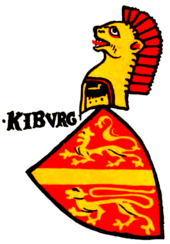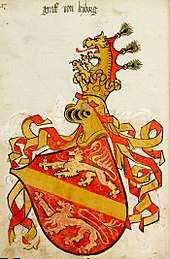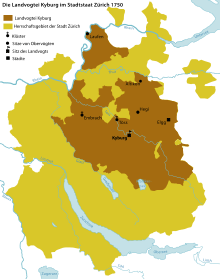Kyburg family
Kyburg (/ˈkaɪbɜːrɡ/; German: [ˈkyːbʊʁk]; also Kiburg) was a noble family of grafen (counts) in the Duchy of Swabia, a cadet line of the counts of Dillingen, who in the late 12th and early 13th century ruled the County of Kyburg, corresponding to much of what is now Northeastern Switzerland.
| von Kyburg | |
|---|---|
 coat of arms (mid 13th century)[1] | |
| Parent house | von Dillingen |
| Country | Swabia |
| Founded | 1180 |
| Founder | Hartmann III von Kyburg |
| Final ruler | Hartmann IV von Kyburg |
| Estate(s) | Zürich |
| Dissolution | 1264 |
The family was one of the four most powerful noble families in the Swiss plateau beside the House of Habsburg, House of Zähringen and the House of Savoy during the 12th century. With the extinction of the Kyburg family's male line in 1264, Rudolph of Habsburg laid claim to the Kyburg lands and annexed them to the Habsburg holdings, establishing the line of "Neu-Kyburg", which was in turn extinct in 1417.
History
Early history
The first line of counts of Kyburg were influential in local politics during the 1020s, but the male line died out in 1078. Kyburg castle, southeast of Winterthur (in the modern canton of Zürich), passed on to the Swabian counts of Dillingen.[2] Through the marriage of Hartmann von Dillingen (d. 1121) with a certain Adelheid, the House of Dillingen acquired the old Kyburg possessions as well as territorial claims in the Thurgau. The exact origin of Adelheid is unclear. She is either the granddaughter of the Count of Grüningen-Winterthur or from a cadet branch of the Winterthur family, the Counts of Nellenburg. She might also be the daughter of Adalbert II von Winterthur (died 1053), the last knight from Winterthur, who died in 1053 at the Battle of Civitate against the Normans.
Expansion of the Kyburg lands
The Kyburg land continued to be part of the possessions of the House of Dillingen until the grandson of Hartmann von Dillingen, Hartmann III (d. 1180), split the Dillingen lands.[3] Adalbert (died 1170) received the Swabian territories, while Hartmann III von Dillingen got the Swiss lands and became Hartmann I of Kyburg. The House of Kyburg were vassals of the Duke of Swabia, who was of the House of Hohenstaufen and would become the Kings of Germany from 1138–1254. When the House of Lenzburg died out in 1172/73, the Kyburgs together with the Hohenstaufen and Zähringen split the Lenzburg possessions between them. The Kyburg family acquired the allodial title to the Vogtei of Windegg or Gaster (today 7 municipalities in the See-Gaster Wahlkreis of St. Gallen) and land around Baden. Later additional Lenzburg territories, the Schänis Abbey and Beromünster, were also acquired by the House of Kyburg.[4]
In 1180 the family began to consolidate their power. They founded the cities of Diessenhofen and Winterthur to help spread their power. They also appointed many of the Lenzburg, and later Zähringen, vassals to be unfree knights or Ministerialis for the Kyburg family.
When the Zähringen family died out in 1218, the Kyburgs grabbed another chance to expand. Anna von Zähringen, the sister of the last Duke of Zähringen, Berthold V, was the wife of Ulrich III von Kyburg (†1227). From the Zähringen line the Kyburgs acquired land west of the Rhine and in Burgundy including the cities of Fribourg, Thun and Burgdorf as well as estates in the canton of Zurich. However, the House of Hohenstaufen, the family of the Holy Roman Emperors, refused to support the Kyburg claims on the city of Zurich and in 1226 on the Abbey of St. Gall. As a result, they turned increasingly away from the Hohenstaufens and in 1243 and were one of the mainstays of the pro-Pope and anti-Holy Roman Emperor Party.
Around 1220 they started to make claims on property and rights that had unclear ownership and was near property that they already owned. In 1225 they founded a burial site for the Chorherrenstift Heiligberg in the center of the property of the former Freiherr von Weisslingen at Winterthur, and in 1233 founded Töss Abbey west of Winterthur. Both sites were endowed with property that they had taken from the Weisslingen and Rossberg families. These two properties served to define the borders between the Kyburg and Rapperswil families.[4]
At the same time the Kyburg family attempted to strengthen themselves through marriage. Hartmann V, a grandson of Ulrich III was engaged to Anna of Rapperswil in 1227. His uncle, Hartmann IV, called the Elder, married Margaret of Savoy while his sister Heilwig, the future mother of King Rudolf I von Habsburg, married Albert IV of Habsburg.
Even though the family continued to found cities and expand, they were declining in power. In 1230 they founded Zug and Baden, then Frauenfeld, Aarau, Lenzburg, and Mellingen. In 1250 they founded Sursee, Weesen and the fortified towns of Kyburg and Laupen. The last two were Richensee and Huttwil which they lost shortly thereafter.
Neu-Kyburg


In 1250/51 the childless Hartmann IV gave the western part of the property with the center of Burgdorf to his nephew Hartmann V. As a result, Hartmann V, who was supported by the Habsburgs, came into conflict repeatedly with the growing city-state of Bern. His uncle had to step in often to keep the peace. When Hartmann V died in 1263, Count Rudolf von Habsburg became the guardian of Hartmann's daughter Anna, and also took over the administration of the western section. In 1264, after the death of Hartman IV, Rudolf stepped in to control the eastern half as well. Though this brought him into conflict with the claims by the widow Margaret of Savoy and her family.
Anna, daughter of Hartmann V, married Eberhard I of Habsburg-Laufenburg. This marriage was intended to secure Habsburg interests in Aargau (Argovia) against Savoy. The son of Eberhard and Anna, Hartmann I (1275–1301) again called himself "of Kyburg". His line came to be known as that of Neu-Kyburg or Kyburg-Burgdorf, persisting until 1417.
In 1322, the brothers Eberhard II and Hartmann II started fighting with each other over who would inherit the undivided lands. The fighting led to the "fratricide at Thun Castle" where Eberhard killed his brother Hartmann. To avoid punishment by his Habsburg overlords, Eberhard fled to Bern. In the following year, he sold the town of Thun, its castle and the land surrounding Thun to Bern. Bern granted the land back to Eberhard as a fief.[4]
The decline of Neu-Kyburg began with a failed raid by Rudolf II on Solothurn, on 11 November 1382. The ensuing conflict with the Old Swiss Confederacy is known as the Burgdorferkrieg (also Kyburgerkrieg). Bern took the opportunity to assert its interests in Aargau against the Habsburgs, and after the Bernese laid siege to Burgdorf, Neu-Kyburg was forced to concede an unfavourable peace. Friedrich V, count of Toggenburg acquired Kyburg and Winterthur in 1384 (lost again in 1402 by Friedrich VII), and Bern bought Thun and Burgdorf, the most important cities of Neu-Kyburg, and their remaining towns passed to Bern and Solothurn by 1408. The last of the Neu-Kyburgs, Berchtold, died destitute in Bern in 1417.
Bailiwick of Kyburg

With the extinction of the comital line, the county passed back to the direct possession of Frederick IV, Duke of Austria, who was forced to sell the county to Zürich in 1424. In the Old Zürich War, most of the territory was given to emperor Frederick III, with only the Neuamt west of the Glatt river remaining with Zürich. However, the Habsburgs again agreed to sell the county to Zürich in 1452. From this time until the French invasion in 1798, the territory was a bailiwick (Landvogtei) administered by a total of 59 successive reeves (Landvögte). The town of Winterthur remained with Habsburg until 1467, when it was bought by Zürich and treated as a separate jurisdiction.
In 1815, Kyburg castle was again made the seat of regional administration (Oberamt). With the creation of the modern Canton of Zürich in 1831, Kyburg lost its administrative role, and the castle was sold to one Franz Heinrich Hirzel of Winterthur who intended to use it as a quarry. To prevent its destruction, the castle was bought by the exiled Polish count Alexander Sobansky (1799–1861) in 1835.
The bailiwick of Kyburg within the Zürichgau was divided into four Ämter:
- Niederamt (or Unteramt) between Glatt and Töss as far as Oberembrach-Bassersdorf.
- Oberamt south of the Töss
- Enneramt between Töss and Thur
- Ausseramt between Thur and Rhine
To this were added two Nebenämter,
- Embracheramt (Embrach, Oberembrach, Lufingen)
- Illnaueramt (Kyburg, Illnau, Brütten, Lindau, Volketswil)
Not part the four Ämter were Wangen and Töss, and the exclaves Ettenhausen and Ebmatingen.
Family tree of the Kyburg family
| HOUSE OF DILLINGEN | HOUSE OF LENZBURG | HOUSE OF ZÄHRINGEN | HOUSE OF HABSBURG | ||||||||||||||||||||||||||||||||||||||||||||||||||||
| Hartmann I of Dillingen † 1121 | Adelheid of Winterthur | ||||||||||||||||||||||||||||||||||||||||||||||||||||||
| Hartmann II † 1134 | Ulrich † 1127 Bishop of Konstanz | Adalbert † 1170 | Richenza of Lenzburg-Baden[5] | ||||||||||||||||||||||||||||||||||||||||||||||||||||
| Hartmann III before 1152 † 1180[5] | Richinza of Lenzburg | ||||||||||||||||||||||||||||||||||||||||||||||||||||||
| Ulrich III of Kyburg before 1183 † 1227[6] | Anna of Zähringen | ||||||||||||||||||||||||||||||||||||||||||||||||||||||
| Ulrich, Bishop of Chur Bishop 1233-1237 | Alice of Lothringen | Werner † 1228 on Crusade | Hartman IV 1213-1264[7] | Margaretha of Savoy †1273 | Hedwig of Kyburg | Albert IV, Count of Habsburg † 1239 | |||||||||||||||||||||||||||||||||||||||||||||||||
| Anna of Rapperschwyl †1253 | Hartmann V 1218-1263 | Elizabeth of Chalon[8] | Rudolph of Habsburg 1218–1291 King of the Romans 1273-1291 | ||||||||||||||||||||||||||||||||||||||||||||||||||||
| Werner †infant | Anna | Eberhard von Habsburg-Laufenburg 1227-1284 | Habsburg Kings and Holy Roman Emperors | ||||||||||||||||||||||||||||||||||||||||||||||||||||
| Counts of Neu-Kyburg or Kyburg-Burgdorf line extinguished 1418 | |||||||||||||||||||||||||||||||||||||||||||||||||||||||
Family tree of the Neu-Kyburg family
| Anna | Eberhard von Habsburg-Laufenburg 1227-1284 | ||||||||||||||||||||||||||||||||||||||||||||||||||||
| Margaretha married Dietrich VII of Cleves | Eberhard I †before 1290 | Peter illegitimate Vogt of Oltingen | Hartmann I c.1275-1301 | Elisabeth of Freiburg c.1280-1322 | |||||||||||||||||||||||||||||||||||||||||||||||||
| Margaritha of Neuchâtel | Hartmann II †1322 murdered by Eberhard II | Eberhard II †17 April 1357 | Anastasia of Signau c. 1313-1382 | Katherina married Albrecht of Werdenberg | |||||||||||||||||||||||||||||||||||||||||||||||||
| Eberhard III | Eberhard IV †14 July 1395 | Anna of Nidau | Hartmann III | Berchtold †1417 Last of the Neu-Kyburg line | |||||||||||||||||||||||||||||||||||||||||||||||||
| Ego II sold his title in 1406 †c.1415 | Rudolph II †1383 | ||||||||||||||||||||||||||||||||||||||||||||||||||||
References
- A coat of arms with four lions, as in that of the counts of Dillingen, is recorded in a seal of 1220. Franz Ernst Pipitz, Die Grafen von Kyburg (1839), 27–30. The coat of arms with two lions is first mentioned as Kiburg in nigro gilvan tabulam fore ponis, obliquansque duos gilvos secet illa leones (i.e. sable, a bend or, two lions [passant] of the same) in the Clipearius Teutonicorum by Konrad von Mure (c. 1264, v. 34), ed. Paul Ganz (1899). The shield is shown in red rather than black in depictions of the 14th century. The black shield mentioned by von Mure was introduced as the municipal arms of Kyburg in 1926. Peter Ziegler, Die Gemeindewappen des Kantons Zürich, Antiquarische Gesellschaft in Zürich, Wappenzeichnungen von Walter Käch und Fritz Brunner, Zürich 1977, p. 67. Die Form mit dem schwarzen Wappenschild wurde 1926 von der Gemeinde Kyburg als Wappen übernommen.
- Encyclopædia Britannica online accessed 11 August 2009
- Genealogy of the House of Kyburg Archived 4 June 2011 at the Wayback Machine (in German) accessed 13 August 2009
- von Kyburg in German, French and Italian in the online Historical Dictionary of Switzerland.
- Kyburg, Hartmann III. von in German, French and Italian in the online Historical Dictionary of Switzerland.
- Kyburg, Ulrich III. von in German, French and Italian in the online Historical Dictionary of Switzerland.
- Kyburg, Hartmann IV. von (der Ältere) in German, French and Italian in the online Historical Dictionary of Switzerland.
- Pipitz, pg.69
- Genealogy of the Kyburg line
- Pipitz, Franz Ernst (1839). Die Grafen von Kyburg. Weidmann.
- Genealogy of Hartmann I accessed 22 February 2013
- Bichsel, Adolf (1899). Graf Eberhard II. von Kyburg. (1299-1357): Ein Beitrag zur Geschichte de Grafen von Habsburg-Kyburg (in German). Bern: H. Körber. pp. 118–119. Some family members omitted for clarity.
External links
- von Kyburg in German, French and Italian in the online Historical Dictionary of Switzerland.